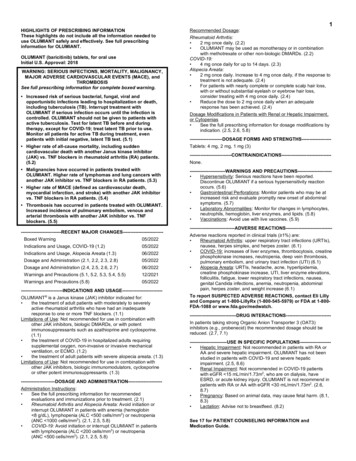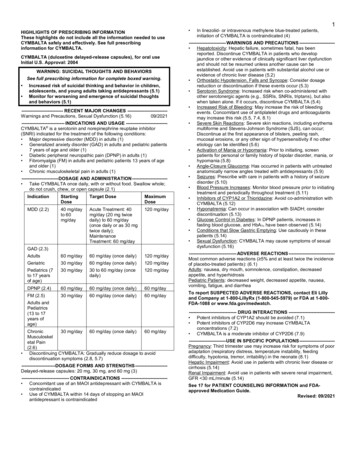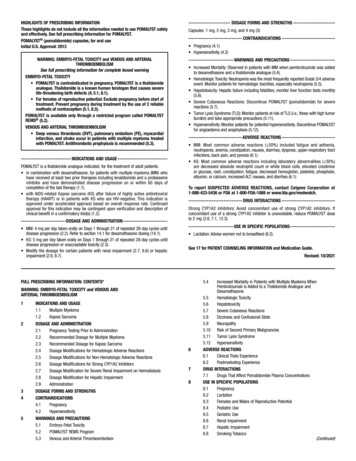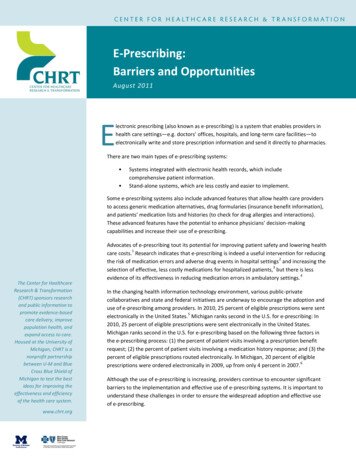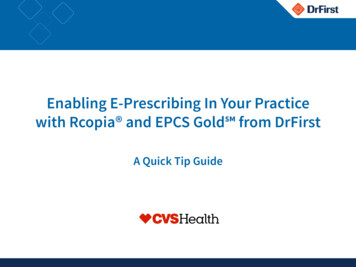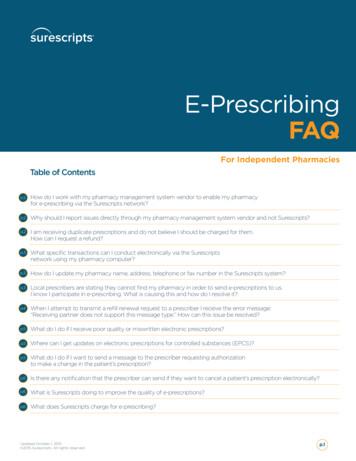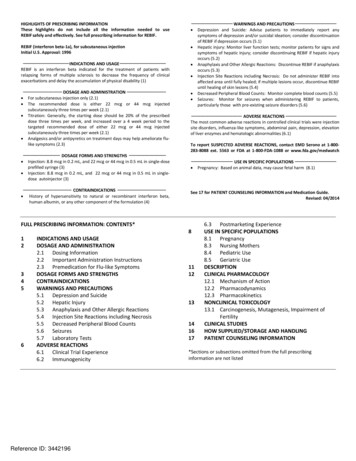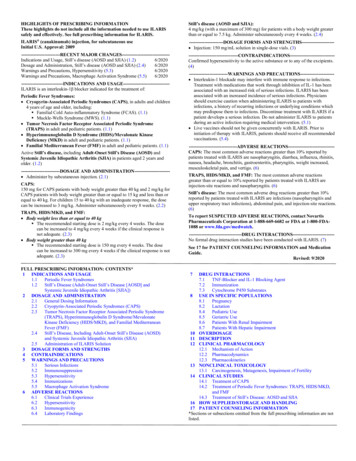
Transcription
History of drug-induced immune-mediated thrombocytopenia fromexenatide products. (4)HIGHLIGHTS OF PRESCRIBING INFORMATIONThese highlights do not include all the information needed to useBYDUREON safely and effectively. See full prescribing information forBYDUREON.----------------------- WARNINGS AND PRECAUTIONS --------------------- Acute Pancreatitis: Including fatal and non-fatal hemorrhagic ornecrotizing pancreatitis has been reported. Discontinue promptly ifpancreatitis is suspected. Do not restart if pancreatitis is confirmed.Consider other antidiabetic therapies if patient has history of pancreatitis.(5.2) Hypoglycemia with Concomitant Use of Insulin Secretagogues or Insulin:Patients taking an insulin secretagogue or insulin may have an increasedrisk of hypoglycemia, including severe hypoglycemia. Reduction in thedose of insulin secretagogue or insulin may be necessary. (5.3) Acute Kidney Injury: May induce nausea and vomiting with transienthypovolemia and may worsen renal function. Postmarketing increasedserum creatinine, renal impairment, worsened chronic renal failure andacute renal failure, sometimes requiring hemodialysis or kidneytransplantation has been reported. Not recommended for use in patientswith eGFR below 45 mL/min/1.73 m2. (5.4, 8.6, 12.3) Gastrointestinal Disease: Not recommended in patients with severegastrointestinal disease (e.g., gastroparesis). (5.5) Immunogenicity: Patients may develop antibodies to exenatide. If there isworsening glycemic control or failure to achieve target glycemic control,consider alternative antidiabetic therapy. (5.6) Hypersensitivity: Serious hypersensitivity reactions (e.g., anaphylaxis andangioedema) have been reported. In such cases, patients are to discontinueBYDUREON and promptly seek medical advice. (5.7) Drug-induced Immune-mediated Thrombocytopenia: Serious bleedingwhich may be fatal has been reported. Discontinue BYDUREON promptlyand avoid re-exposure to exenatide. (5.8) Injection-site Reactions: Serious injection-site reactions with or withoutsubcutaneous nodules have been reported. (5.9) Acute Gallbladder Disease: If cholelithiasis or cholecystitis are suspected,gallbladder studies are indicated. (5.10)BYDUREON (exenatide extended-release) for injectable suspension, forsubcutaneous useInitial U.S. Approval: 2005WARNING: RISK OF THYROID C-CELL TUMORSSee full prescribing information for complete boxed warning. Exenatide extended-release causes thyroid C-cell tumors atclinically relevant exposures in rats. It is unknown whetherBYDUREON causes thyroid C-cell tumors, including medullarythyroid carcinoma (MTC) in humans, as the human relevance ofexenatide extended-release-induced rodent thyroid C-cell tumorshas not been determined (5.1, 13.1). BYDUREON is contraindicated in patients with a personal orfamily history of MTC or in patients with Multiple EndocrineNeoplasia syndrome type 2 (MEN 2). Counsel patients regardingthe potential risk of MTC and the symptoms of thyroid tumors (4,5.1).-------------------------- RECENT MAJOR CHANGES -------------------------Indications and Usage (1)07/2021Dosage and Administration (2)07/2021--------------------------- INDICATIONS AND USAGE -------------------------BYDUREON is a glucagon-like peptide-1 (GLP-1) receptor agonist indicatedas an adjunct to diet and exercise to improve glycemic control in adults andpediatric patients aged 10 years and older with type 2 diabetes mellitus. (1)Limitations of Use: Not recommended as first-line therapy for patients inadequately controlledon diet and exercise. (1) Should not be used to treat type 1 diabetes. (1) BYDUREON is an extended-release formulation of exenatide. Do notcoadminister with other exenatide-containing products. (1) Has not been studied in patients with a history of pancreatitis. Considerother antidiabetic therapies in patients with a history of pancreatitis. (1, 5.2)------------------------------ ADVERSE REACTIONS ----------------------------Most common ( 5%) and occurring more frequently than comparator inclinical trials: nausea, diarrhea, headache, vomiting, constipation, injectionsite pruritus, injection-site nodule, and dyspepsia. (6.1)To report SUSPECTED ADVERSE REACTIONS, contact AstraZenecaat 1-800-236-9933 or FDA at 1-800-FDA-1088 or www.fda.gov/medwatch.---------------------- DOSAGE AND ADMINISTRATION --------------------- Administer 2 mg by subcutaneous injection once every seven days(weekly), at any time of day and with or without meals. (2.1) Administer immediately after the dose is prepared. (2.2)------------------------------ DRUG INTERACTIONS ---------------------------- May impact absorption of orally administered medications. (7) Warfarin: Postmarketing reports with exenatide of increased internationalnormalized ratio (INR) sometimes associated with bleeding. Monitor INRfrequently until stable upon initiation of BYDUREON therapy. (7)--------------------- DOSAGE FORMS AND STRENGTHS -------------------Extended-release for injectable suspension available as: (3) Single-dose tray containing 2 mg of exenatide in single-dose vial Single-dose pen containing 2 mg of exenatide----------------------- USE IN SPECIFIC POPULATIONS --------------------- Pregnancy: Use during pregnancy only if the potential benefit justifies therisk to the fetus. (8.1)------------------------------ CONTRAINDICATIONS ---------------------------- Personal or family history of medullary thyroid carcinoma or in patientswith Multiple Endocrine Neoplasia syndrome type 2. (4) Prior serious hypersensitivity reaction to exenatide or any of the productcomponents. (4)See 17 for PATIENT COUNSELING INFORMATION and MedicationGuideRevised: 07/2021FULL PRESCRIBING INFORMATION: CONTENTS*WARNING: RISK OF THYROID C-CELL TUMORS1INDICATIONS AND USAGE2DOSAGE AND ADMINISTRATION2.1 Recommended Dosing2.2 Administration Instructions3DOSAGE FORMS AND STRENGTHS4CONTRAINDICATIONS5WARNINGS AND PRECAUTIONS5.1 Risk of Thyroid C-cell Tumors5.2 Acute Pancreatitis5.3 Hypoglycemia with Concomitant Use of Insulin Secretagogues orInsulin5.4 Acute Kidney Injury5.5 Gastrointestinal Disease5.6 Immunogenicity5.7 Hypersensitivity67810111Reference ID: 48299225.8 Drug-Induced Thrombocytopenia5.9 Injection-Site Reactions5.10 Acute Gallbladder DiseaseADVERSE REACTIONS6.1 Clinical Trial Experience6.2 Immunogenicity6.3 Postmarketing ExperienceDRUG INTERACTIONSUSE IN SPECIFIC POPULATIONS8.1 Pregnancy8.2 Lactation8.4 Pediatric Use8.5 Geriatric Use8.6 Renal ImpairmentOVERDOSAGEDESCRIPTION
14.2 EXSCEL Cardiovascular Outcomes Trial in Patients with Type 2Diabetes Mellitus14.3 Glycemic Control Trial in Pediatric Patients 10 Years of Age andOlder with Type 2 Diabetes Mellitus16HOW SUPPLIED/STORAGE AND HANDLING17PATIENT COUNSELING INFORMATION12CLINICAL PHARMACOLOGY12.1 Mechanism of Action12.2 Pharmacodynamics12.3 Pharmacokinetics13NONCLINICAL TOXICOLOGY13.1 Carcinogenesis, Mutagenesis, Impairment of Fertility14CLINICAL STUDIES14.1 Glycemic Control Trials in Adults with Type 2 Diabetes Mellitus*Sections or subsections omitted from the full prescribing information are notlisted.2Reference ID: 4829922
FULL PRESCRIBING INFORMATIONWARNING: RISK OF THYROID C-CELL TUMORS 1Exenatide extended-release causes an increased incidence in thyroid C-cell tumors atclinically relevant exposures in rats compared to controls. It is unknown whetherBYDUREON causes thyroid C-cell tumors, including medullary thyroid carcinoma(MTC), in humans, as the human relevance of exenatide extended-release-induced rodentthyroid C-cell tumors has not been determined [see Warnings and Precautions (5.1) andNonclinical Toxicology (13.1)].BYDUREON is contraindicated in patients with a personal or family history of MTC andin patients with Multiple Endocrine Neoplasia syndrome type 2 (MEN 2). Counsel patientsregarding the potential risk for MTC with the use of BYDUREON and inform them ofsymptoms of thyroid tumors (e.g., mass in the neck, dysphagia, dyspnea, persistenthoarseness). Routine monitoring of serum calcitonin or using thyroid ultrasound is ofuncertain value for detection of MTC in patients treated with BYDUREON [seeContraindications (4) and Warnings and Precautions (5.1)].INDICATIONS AND USAGEBYDUREON is indicated as an adjunct to diet and exercise to improve glycemic control in adults andpediatric patients aged 10 years and older with type 2 diabetes mellitus [see Clinical Studies (14)].Limitations of Use: BYDUREON is not recommended as first-line therapy for patients who have inadequate glycemiccontrol on diet and exercise because of the uncertain relevance of the rat thyroid C-cell tumorfindings to humans [see Warnings and Precautions (5.1)]. BYDUREON is not indicated for use in patients with type 1 diabetes mellitus. BYDUREON is an extended-release formulation of exenatide and should not be used with otherproducts containing the active ingredient exenatide. BYDUREON has not been studied in patients with a history of pancreatitis. Consider otherantidiabetic therapies in patients with a history of pancreatitis [see Warnings and Precautions (5.2)and Adverse Reactions (6.1)].2Reference ID: 4829922
2DOSAGE AND ADMINISTRATION2.1Recommended Dosing The recommended dose of BYDUREON is 2 mg subcutaneously once every 7 days (weekly).The dose can be administered at any time of day, with or without meals. Discontinue an immediate- or extended-release exenatide product prior to initiation ofBYDUREON. Patients changing from immediate-release exenatide to BYDUREON mayexperience transient (approximately 2 to 4 weeks) elevations in blood glucose concentrations. The day of weekly administration can be changed, if necessary, as long as the last dose wasadministered 3 or more days before the new day of administration. If a dose is missed, administer the dose as soon as noticed, provided the next regularly scheduleddose is due at least 3 days later. Thereafter, patients can resume their usual dosing schedule ofonce every 7 days (weekly). If a dose is missed and the next regularly scheduled dose is due 1 or 2 days later, do notadminister the missed dose and instead resume BYDUREON with the next regularly scheduleddose.2.2Administration Instructions There are two presentations of BYDUREON (i.e., a single dose tray and a single dose pen). Eachpresentation of BYDUREON requires constitution prior to use to obtain a final concentration of2 mg of exenatide per 0.65 mL of suspension. Prior to initiation, train patients and caregivers on proper mixing and injection [see Instruction forUse]. Instruct caregivers to assist pediatric patients with mixing and administration. Inspect BYDUREON visually before use. The suspension should appear white to off-white andcloudy. Do not use if particulate matter is present or if discoloration is observed. Immediately after the dose is prepared, administer BYDUREON subcutaneously to the abdomen,thigh, or upper arm region. Instruct patients to use a different injection site each week wheninjecting in the same region. When using BYDUREON with insulin, always administer BYDUREON and insulin as separateinjections and never mix the products. It is acceptable to inject BYDUREON and insulin in thesame body region but the injections should not be adjacent to each other.3DOSAGE FORMS AND STRENGTHSExtended-release for injectable suspension available as: Single-dose tray which contains one single dose vial of 2 mg exenatide white to off-whitepowder, one vial connector, one prefilled diluent syringe, and two needles (one provided as aspare).3Reference ID: 4829922
4Single-dose pen which contains 2 mg of exenatide white to off-white powder, diluent, andincludes one needle. Each carton contains one spare needle.CONTRAINDICATIONSBYDUREON is contraindicated in patients with: A personal or family history of medullary thyroid carcinoma (MTC) or in patients with MultipleEndocrine Neoplasia syndrome type 2 (MEN 2). A prior serious hypersensitivity reaction to exenatide or to any of the excipients in BYDUREON.Serious hypersensitivity reactions including anaphylaxis and angioedema have been reported withBYDUREON [see Warnings and Precautions (5.7)]. A history of drug-induced immune-mediated thrombocytopenia from exenatide products. Seriousbleeding, which may be fatal, from drug-induced immune-mediated thrombocytopenia has beenreported with exenatide use [see Warnings and Precautions (5.8)].5WARNINGS AND PRECAUTIONS5.1Risk of Thyroid C-cell TumorsIn both genders of rats, exenatide extended-release caused a dose-related and treatment-duration–dependent increase in the incidence of thyroid C-cell tumors (adenomas and/or carcinomas) at clinicallyrelevant exposures compared to controls [see Nonclinical Toxicology (13.1)]. A statistically significantincrease in malignant thyroid C-cell carcinomas was observed in female rats receiving exenatideextended-release at 25-times clinical exposure compared to controls and higher incidences were noted inmales above controls in all treated groups at 2-times clinical exposure. The potential of exenatideextended-release to induce C-cell tumors in mice has not been evaluated. Other GLP-1 receptor agonistshave also induced thyroid C-cell adenomas and carcinomas in male and female mice and rats at clinicallyrelevant exposures. It is unknown whether BYDUREON will cause thyroid C-cell tumors, includingmedullary thyroid carcinoma (MTC), in humans as the human relevance of exenatideextended-release-induced rodent thyroid C-cell tumors has not been determined.Cases of MTC in patients treated with liraglutide, another GLP-1 receptor agonist, have been reported inthe postmarketing period; the data in these reports are insufficient to establish or exclude a causalrelationship between MTC and GLP-1 receptor agonist use in humans.BYDUREON is contraindicated in patients with a personal or family history of MTC or in patients withMEN 2. Counsel patients regarding the potential risk of MTC with the use of BYDUREON and informthem of symptoms of thyroid tumors (e.g., a mass in the neck, dysphagia, dyspnea, persistent hoarseness).Routine monitoring of serum calcitonin or using thyroid ultrasound is of uncertain value for earlydetection of MTC in patients treated with BYDUREON. Such monitoring may increase the risk ofunnecessary procedures, due to the low specificity of serum calcitonin testing for MTC and a highbackground incidence of thyroid disease. Significantly elevated serum calcitonin may indicate MTC andpatients with MTC usually have values 50 ng/L. If serum calcitonin is measured and found to be4Reference ID: 4829922
elevated, the patient should be further evaluated. Patients with thyroid nodules noted on physicalexamination or neck imaging should also be further evaluated.5.2Acute PancreatitisBased on postmarketing data, exenatide has been associated with acute pancreatitis, including fatal andnon-fatal hemorrhagic or necrotizing pancreatitis. After initiation of BYDUREON, observe patientscarefully for signs and symptoms of pancreatitis (including persistent severe abdominal pain, sometimesradiating to the back, which may or may not be accompanied by vomiting). If pancreatitis is suspected,BYDUREON should promptly be discontinued and appropriate management should be initiated. Ifpancreatitis is confirmed, BYDUREON should not be restarted. Consider antidiabetic therapies other thanBYDUREON in patients with a history of pancreatitis.5.3Hypoglycemia with Concomitant Use of Insulin Secretagogues or InsulinPatients receiving BYDUREON in combination with an insulin secretagogue (e.g., sulfonylurea) orinsulin may have an increased risk of hypoglycemia, including severe hypoglycemia [see AdverseReactions (6.1) and Drug Interactions (7)].The risk of hypoglycemia may be lowered by a reduction in the dose of sulfonylurea (or otherconcomitantly administered insulin secretagogues) or insulin. Inform patients using these concomitantmedications of the risk of hypoglycemia and educate them on the signs and symptoms of hypoglycemia.5.4Acute Kidney InjuryBYDUREON may induce nausea and vomiting with transient hypovolemia and may worsen renalfunction. There have been postmarketing reports of altered renal function with exenatide, includingincreased serum creatinine, renal impairment, worsened chronic renal failure and acute renal failure,sometimes requiring hemodialysis or kidney transplantation. Some of these events occurred in patientsreceiving one or more pharmacologic agents known to affect renal function or hydration status such asangiotensin converting enzyme inhibitors, nonsteroidal anti-inflammatory drugs, or diuretics. Someevents occurred in patients who had been experiencing nausea, vomiting or diarrhea, with or withoutdehydration. Reversibility of altered renal function has been observed in many cases with supportivetreatment and discontinuation of potentially causative agents, including BYDUREON. BYDUREON isnot recommended for use in patients with an eGFR below 45 mL/min/1.73 m2 [see Use in SpecificPopulations (8.6)].5.5Gastrointestinal DiseaseExenatide has not been studied in patients with severe gastrointestinal disease, including gastroparesis.Because exenatide is commonly associated with gastrointestinal adverse reactions, including nausea,vomiting, and diarrhea, the use of BYDUREON is not recommended in patients with severegastrointestinal disease.5.6ImmunogenicityPatients may develop antibodies to exenatide following treatment with BYDUREON. Anti-exenatideantibodies were measured in BYDUREON-treated patients in five of the six comparator-controlled 24- to30-week studies of BYDUREON. In 6% of BYDUREON-treated patients, antibody formation was5Reference ID: 4829922
associated with an attenuated glycemic response. If there is worsening glycemic control or failure toachieve targeted glycemic control, consider alternative antidiabetic therapy [see Adverse Reactions (6.1)and (6.2)].5.7HypersensitivityThere have been postmarketing reports of serious hypersensitivity reactions (e.g., anaphylaxis andangioedema) in patients treated with exenatide. If a hypersensitivity reaction occurs, the patient shoulddiscontinue BYDUREON and promptly seek medical advice [see Contraindications (4) and AdverseReactions (6.3)]. Inform and closely monitor patients with a history of anaphylaxis or angioedema withanother GLP-1 receptor agonist for allergic reactions, because it is unknown whether such patients will bepredisposed to anaphylaxis with BYDUREON.5.8Drug-Induced ThrombocytopeniaSerious bleeding, which may be fatal, from drug-induced immune-mediated thrombocytopenia has beenreported in the postmarketing setting with exenatide use. Drug-induced thrombocytopenia is animmune-mediated reaction, with exenatide-dependent anti-platelet antibodies. In the presence ofexenatide, these antibodies cause platelet destruction. If drug-induced thrombocytopenia is suspected,discontinue BYDUREON immediately and do not re-expose the patient to exenatide. Upondiscontinuation, thrombocytopenia can persist due to the prolonged exenatide exposure fromBYDUREON (about 10 weeks) [see Adverse Reactions (6.3)].5.9Injection-Site ReactionsThere have been postmarketing reports of serious injection-site reactions (e.g., abscess, cellulitis, andnecrosis), with or without subcutaneous nodules, with the use of BYDUREON. Isolated cases requiredsurgical intervention [see Adverse Reactions (6.1)].5.10Acute Gallbladder DiseaseAcute events of gallbladder disease have been reported in GLP-1 receptor agonist trials. In the EXSCELtrial [see Clinical Studies (14.2)], 1.9% of BYDUREON-treated patients and 1.4% of placebo-treatedpatients reported an acute event of gallbladder disease, such as cholelithiasis or cholecystitis. Ifcholelithiasis is suspected, gallbladder studies and appropriate clinical follow-up are indicated.6ADVERSE REACTIONSThe following serious adverse reactions are described below or elsewhere in the prescribing information: Risk of Thyroid C-cell Tumors [see Warnings and Precautions (5.1)]Acute Pancreatitis [see Warnings and Precautions (5.2)]Hypoglycemia with Concomitant Use of Insulin Secretagogues or Insulin [see Warnings andPrecautions (5.3)]Acute Kidney Injury [see Warnings and Precautions (5.4)]Gastrointestinal Disease [see Warnings and Precautions (5.5)]Immunogenicity [see Warnings and Precautions (5.6)]Hypersensitivity [see Warnings and Precautions (5.7)]6Reference ID: 4829922
Drug-Induced Thrombocytopenia [see Warnings and Precautions (5.8)]Injection-Site Reactions [see Warnings and Precautions (5.9)]Acute Gallbladder Disease [see Warnings and Precautions (5.10)]6.1Clinical Trial ExperienceBecause clinical trials are conducted under widely varying conditions, adverse reaction rates observed inthe clinical trials of a drug cannot be directly compared to rates in the clinical trials of another drug andmay not reflect the rates observed in practice.The safety data presented below are derived from six comparator-controlled trials of BYDUREON inadult patients who entered the studies not achieving adequate glycemic control on their current therapy[see Clinical Studies (14.1)]. In a double-blind 26-week trial, patients on diet and exercise were treatedwith BYDUREON 2 mg once every 7 days (weekly), sitagliptin 100 mg daily, pioglitazone 45 mg daily,or metformin 2000 mg daily. In a double-blind 26-week trial, patients on metformin were treated withBYDUREON 2 mg once every 7 days (weekly), sitagliptin 100 mg daily, or pioglitazone 45 mg daily. Inan open-label 26-week trial, patients on metformin or metformin plus sulfonylurea were treated withBYDUREON 2 mg once every 7 days (weekly) or optimized insulin glargine. In two open-label 24- to30-week studies, patients on diet and exercise or metformin, a sulfonylurea, a thiazolidinedione, orcombination of oral agents were treated with BYDUREON 2 mg once every 7 days (weekly) or BYETTA10 mcg twice daily. In an open-label 26-week trial, patients on metformin, a sulfonylurea, metformin plusa sulfonylurea, or metformin plus pioglitazone were treated with BYDUREON 2 mg every 7 days(weekly) or liraglutide 1.8 mg once daily.The safety of BYDUREON in pediatric patients age 10 to less than 18 years with type 2 diabetes wassimilar to that observed in adults [see Clinical Studies (14.3)].Common Adverse ReactionsTables 1 and 2 summarize adverse reactions in adults with an incidence 5% reported in the sixcomparator-controlled 24- to 30-week trials of BYDUREON used as monotherapy or as add-on tometformin, a sulfonylurea, a thiazolidinedione, or combination of these oral antidiabetic agents.Table 1: Adverse Reactions Reported in 5% of BYDUREON-Treated Patients withType 2 Diabetes Mellitus in Monotherapy onHeadacheDyspepsia26-Week Monotherapy TrialBYDUREONSitagliptinPioglitazone2 mg100 mg30-45 (mean doseN 248N 16340) mg%%N .81.88.04.97Reference ID: 4829922Metformin1000-2500 (mean dose2077) mgN 246%6.912.610.23.312.23.3
N number of intent-to-treat patients.Note: Percentages are based on the number of intent-to-treat patients in each treatment group.*Patients in the sitagliptin, pioglitazone, and metformin treatment groups received weekly placebo injections.Table 2: Adverse Reactions Reported in 5% of BYDUREON-Treated Patients withType 2 Diabetes Mellitus in 24- to 30-Week Add-On Combination Therapy Trials26-Week Add-On to Metformin TrialPioglitazoneSitagliptinBYDUREON45 mg100 mg2 mgN 165N 166N gue5.60.63.0Dyspepsia5.03.62.4Decreased appetite5.01.20.0Injection-site pruritus*5.04.81.226-Week Add-On to Metformin or Metformin Sulfonylurea TrialBYDUREONInsulin Glargine Titrated2 mgN 223N ction-site nodule6.00.030-Week Monotherapy or as Add-On to Metformin, a Sulfonylurea, a Thiazolidinedione, orCombination of Oral Agents TrialBYDUREONBYETTA2 mg10 mcgN 148N 6Injection-site pruritus18.21.4Constipation10.16.2Gastroenteritis viral8.85.5Gastroesophageal reflux disease7.44.1Dyspepsia7.42.1Injection-site -site hematoma5.411.08Reference ID: 4829922
Table 2: Adverse Reactions Reported in 5% of BYDUREON-Treated Patients withType 2 Diabetes Mellitus in 24- to 30-Week Add-On Combination Therapy Trials24-Week Monotherapy or as Add-On to Metformin, a Sulfonylurea, a Thiazolidinedione, orCombination of Oral Agents TrialBYDUREONBYETTA2 mg10 mcgN 129N 123%%Nausea14.035.0Diarrhea9.34.1Injection-site erythema5.42.426-Week Add-On to Metformin, a Sulfonylurea, Metformin Sulfonylurea, or Metformin Pioglitazone TrialBYDUREON2 mgN 461%Injection-site nodule10.4Nausea9.3Diarrhea6.1N number of intent-to-treat patients.Note: Percentages are based on the number of intent-to-treat patients in each treatment group.*Patients in the sitagliptin, pioglitazone, and metformin treatment groups received weekly placebo injections.Nausea was a common adverse reaction associated with initiation of treatment with BYDUREON andusually decreased over time.Adverse Reactions Leading to Study WithdrawalThe incidence of withdrawal due to adverse reactions in adults was 4.1% (N 57) for BYDUREONtreated patients, 4.9% (N 13) for BYETTA-treated patients, and 2.9% (N 46) for other comparatortreated patients in the six comparator-controlled 24- to 30-week trials. The most common classes ofadverse reactions (0.5%) leading to withdrawal for BYDUREON-treated patients were, GastrointestinalDisorders 1.6% (N 22) versus 4.1% (N 11) for BYETTA and 1.9% (N 30) for other comparators, andAdministration Site Conditions 0.8% (N 11) versus 0.0% for BYETTA and 0.2% (N 3) for othercomparators. The most frequent adverse reactions within each of these respective classes were, nausea0.4% (N 6) for BYDUREON versus 1.5% (N 4) for BYETTA and 0.8% (N 12) for other comparators,and injection-site nodule, 0.4% (N 6) for BYDUREON versus 0.0% for BYETTA and 0.0% for othercomparators.HypoglycemiaTable 3 summarizes the incidence of hypoglycemia (defined as the presence of symptoms ofhypoglycemia with a concomitant glucose 54 mg/dL and the ability to self-treat) in the six comparatorcontrolled 24- to 30-week trials in adults of BYDUREON used as monotherapy or as add-on tometformin, a sulfonylurea, a thiazolidinedione, or combination of these oral antidiabetic agents.9Reference ID: 4829922
Table 3: Incidence (% of Subjects) of Hypoglycemia* in Clinical Trials in Patients withType 2 Diabetes Mellitus26-Week Monotherapy TrialBYDUREON 2 mg (N 248)2.0%Sitagliptin 100 mg (N 163)0.0%Pioglitazone 30-45 (mean dose 40) mg (N 163)0.0%Metformin 1000-2500 (mean dose 2077) mg (N 246)0.0%26-Week Add-On to Metformin TrialBYDUREON 2 mg (N 160)1.3%Sitagliptin 100 mg (N 166)3.0%Pioglitazone 45 mg (N 165)1.2%26-Week Add-On to Metformin or Metformin Sulfonylurea TrialWith Concomitant Sulfonylurea Use (N 136)BYDUREON 2 mg (N 70)20.0%Titrated Insulin Glargine (N 66)43.9%Without Concomitant Sulfonylurea Use (N 320)BYDUREON 2 mg (N 163)3.7%Titrated Insulin Glargine† (N 157)19.1%24-Week Monotherapy or Add-On to Metformin, a Sulfonylurea, a Thiazolidinedione, orCombination of Oral Agents TrialWith Concomitant Sulfonylurea Use (N 74)BYDUREON 2 mg (N 40)12.5%BYETTA 10 mcg (N 34)11.8%Without Concomitant Sulfonylurea Use (N 178)BYDUREON 2 mg (N 89)0.0%BYETTA 10 mcg (N 89)0.0%30-Week Monotherapy or Add-On to Metformin, a Sulfonylurea, a Thiazolidinedione, orCombination of Oral Agents TrialWith Concomitant Sulfonylurea Use (N 107)BYDUREON 2 mg (N 55)14.5%BYETTA 10 mcg (N 52)15.4%Without Concomitant Sulfonylurea Use (N 186)BYDUREON 2 mg (N 93)0.0%BYETTA 10 mcg (N 93)1.1%26-Week as Add-On to Metformin, a Sulfonylurea, Metformin Sulfonylurea, or Metformin Pioglitazone TrialWith Concomitant Sulfonylurea Use (N 590)BYDUREON 2 mg (N 294)15.3%Without Concomitant Sulfonylurea Use (N 321)BYDUREON 2 mg (N 167)3.6%N number of intent-to-treat patients.Note: Percentages are based on the number of intent-to-treat patients in each treatment group.*Reported event that has symptoms consistent with hypoglycemia with a concomitant glucose 54 mg/dL and the patientwas able to self-treat.†Insulin glargine was dosed to a target fasting glucose concentration of 72 to 100 mg/dL. The mean dose of insulinglargine was 10 units/day at baseline and 31 units/day at endpoint.In the 24-week pediatric placebo-controlled clinical trial [see Clinical Studies (14.3)], 2 (3.4%) ofBYDUREON-treated patients with type 2 diabetes had hypoglycemia with a blood glucose 54 mg/dL10Reference ID: 4829922
with or without symptoms and 1 (1.7%) had severe hypoglycemia (defined as an episode with severecognitive impairment requiring external assistance for recovery).Injection-Site Adverse ReactionsIn five comparator-controlled 24- to 30-week trials in adults, injection-site reactions were observed morefrequently in patients treated with BYDUREON (17.1%) than in patients treated with BYETTA (12.7%),titrated insulin glargine (1.8%), or those patients who received placebo injections (sitagliptin (10.6%),pioglitazone (6.4%), and metformin (13.0%) treatment groups). These reactions for patients treated withBYDUREON were more commonly observed in antibody-positive patients (14.2%) compared withantibody-negative patients (3.1%), with a greater incidence in those with higher titer antibodies. Incidenceof injection-site reactions for patients treated with BYETTA was similar for antibody-positive patients(5.8%) and antibody-negative patients (7.0%). One percent of patients treated with BYDUREONwithdrew due to injection-site adverse reactions (injection-site mass, injection-site nodule, injection-sitepruritus, and injection-si
BYDUREON is contraindicated in patients with a personal or family history of MTC and in patients with Multiple Endocrine Neoplasia syndrome type 2 (MEN 2). Counsel patients regarding the potential risk for MTC with the use of BYDUREON and inform them of symptoms of thyroid tumors (e.g., mass in the neck, dysphagia, dyspnea, persistent

